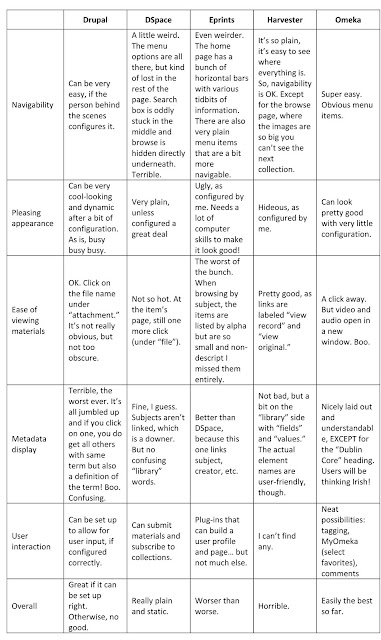This week I became a data farmer, and I harvested collections from other repositories and archives in order to populate my own fictitious website. I sort of felt like the Lady of the Manor, what with all the power felt in thousands of digital objects now in my control. Sort of.
At any rate, another assignment was to poke around the
Open Archives service providers list and look at some of the sites, do searches, etc. Personally, I find the list a bit confusing, even though names, URLs, and descriptions are provided. I think it's because any one service provider doesn't do (or isn't) exactly the same thing as other providers on the list. So, I wasn't ever 100% what I was looking at.
I checked a few out. One is the
Perseus Digital Library, because I knew it has some Classic material and my collection has some as well. I didn't really like the layout and I felt it was a bit difficult to navigate. Unlike a classmate, I didn't think it was clear what repository an item was harvested from-- unless most are at Tufts, where Perseus is located. Another site I looked at, whose layout I also didn't like, was
Avano. Both of these sites had stark-looking search boxes. The browse feature in Perseus was pretty good, but all I found on Avano was a way to browse providers, not topics.
Cyclades was undoubtedly the strangest site. That they recommend new users read an explanatory document before beginning on Cyclades should tell you something. It had very few materials on it (that I could find) and they were of "minutes." Not sure of what. Maybe I should have read the manual.
The layout on
GEO-LEO was a step up. Obvious browse topics pop up on the home page. I could find search results easy enough-- but never could actually get to the object itself. So that was no good.
Without a doubt the "best" site I visited was the
Sheet Music Consortium. It had attractive images, easy navigation, and search. The browse feature was pretty terrible, as it actually brought me back to search; other browse-type menu items were crummy too and hard to read. But in using search I could find items easily and was taken to the original site in a new window.
The best type of federated collection would include:
- Attractive site
- Obvious navigation points
- Browse by topic, collection, and providers
- Thumbnail images (if images) that link to original
- Metadata that is listed in a non-library way that will make sense to users and will link to other metadata (e.g. subject/topic metadata)
Huge federated sites would need to break apart tasks to different work groups so that objects are not lost in a sea of data.
Europeana is an excellent example of a consortium that, while not perfect, has many of what I consider to be important elements.

